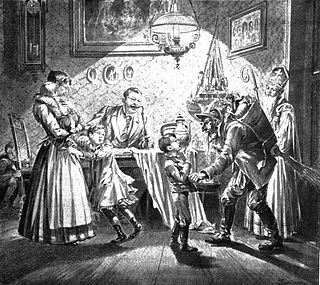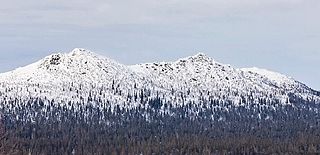
Father Christmas is the traditional English name for the personification of Christmas. Although now known as a Christmas gift-bringer, and typically considered to be synonymous with Santa Claus, he was originally part of a much older and unrelated English folkloric tradition. The recognisably modern figure of the English Father Christmas developed in the late Victorian period, but Christmas had been personified for centuries before then.

A nisse, tomte, tomtenisse, or tonttu is a household spirit from Nordic folklore which has always been described as a small human-like creature wearing a red cap and gray clothing, doing house and stable chores, and expecting to be rewarded at least once a year around winter solstice (yuletide), with the gift of its favorite food, the porridge.

Rudolph the Red-Nosed Reindeer is a fictional reindeer created by Robert L. May. Rudolph is usually depicted as the ninth and youngest of Santa Claus's reindeer, using his luminous red nose to lead the reindeer team and guide Santa's sleigh on Christmas Eve. Though he initially receives ridicule for his nose as a fawn, the brightness of his nose is so powerful that it illuminates the team's path through harsh winter weather. Ronald D. Lankford, Jr., described Rudolph's story as "the fantasy story made to order for American children: each child has the need to express and receive approval for his or her individuality and special qualities. Rudolph's story embodies the American Dream for the child, writ large because of the cultural significance of Christmas."

The companions of Saint Nicholas are a group of closely related figures who accompany Saint Nicholas throughout the territories formerly in the Holy Roman Empire or the countries that it influenced culturally. These characters act as a foil to the benevolent Christmas gift-bringer, threatening to thrash or abduct disobedient children. Jacob Grimm associated this character with the pre-Christian house spirit which could be benevolent or malicious, but whose mischievous side was emphasized after Christianization. The association of the Christmas gift-bringer with elves has parallels in English and Scandinavian folklore, and is ultimately and remotely connected to the Christmas elf in modern American folklore.

Korvatunturi is a fell in Lapland, on the border between Finland and Russia. Its Finnish part is within Urho Kekkonen National Park in the municipality of Savukoski. In Finnish the name Korvatunturi means "Ear Fell", referring to the mountain's distinctive profile.

Jul or jol is the term used for the Christmas holiday season in Scandinavia and parts of Scotland. Originally, jul was the name of a month in the old Germanic calendar. The concept of jul as a period of time rather than a specific event prevailed in Scandinavia; in modern times, jul is a period of time stretching from the fourth Sunday before Christmas Eve, December 24, to (traditionally) mid-January at the date of Epiphany with the month of December and Christmas, and the week up to the New Year, as its highlight. The modern English yule and yuletide are cognates with this term.

The Yule goat is a Scandinavian and Northern European Yule and Christmas symbol and tradition. Its origin is from Germanic paganism and has existed in many variants during Scandinavian history. Modern representations of the Yule goat are typically made of straw.

In Christmas folklore and legends, Santa's Workshop is the workshop where Santa Claus and his elves live and make the toys and presents given out at Christmas. The exact location of Santa's workshop varies depending upon local culture, however it is generally said to be somewhere around or on the North Pole. There are at least eight claimed locations for his workshop. For example, people in Canada send letters to Santa's Workshop at his North Pole location in Canada, with the unique postal code of "H0H 0H0". In the United States, the workshop is considered to be a sprawling commune located at the North Pole. Some people in the United Kingdom and Finland believe that Father Christmas' Workshop is located in Finland in Korvatunturi, Lapland. In addition to housing the factory where toys are either manufactured or distributed by the elves, the complex also houses the residence of Santa, his wife, companions, and all of the reindeer.

In traditional Western festive legend and popular culture, Santa Claus's reindeer are said to pull a sleigh through the night sky to help Santa Claus deliver gifts to children on Christmas Eve.

Julebukking is a Christmas tradition of Scandinavian origin.

Santa Claus is a legendary figure originating in Western Christian culture who is said to bring gifts during the late evening and overnight hours on Christmas Eve. Christmas elves are said to make the gifts in Santa's workshop, while flying reindeer pull his sleigh through the air.

Jul, the Danish Jule and Christmas, is celebrated throughout December starting either at the beginning of Advent or on 1 December with a variety of traditions. Christmas Eve, Juleaften, the main event of Jul, is celebrated on the evening of 24 December, the evening before the two Christmas holidays, 25 and 26 December. Celebrating on the eve before Christmas is also used for most other holidays in Denmark.

Pinocchio's Christmas is a 1980 Christmas stop motion television special produced by Rankin/Bass Productions that is a holiday adaptation of the 1883 novel The Adventures of Pinocchio by Carlo Collodi. The special premiered on ABC on December 3, 1980. It aired annually during the Christmas season on Freeform and as of 2018 airs on AMC.

In English-speaking cultures, Christmas elves are diminutive elves that live with Santa Claus at the North Pole and act as his helpers. Christmas elves are usually depicted as green- or red-clad, with large, pointy ears and wearing pointy hats. They are most often depicted as humanoids, but sometimes as furry mammals with tails. Santa's elves are often said to make the toys in Santa's workshop and take care of his reindeer, among other tasks.

Rare Exports: A Christmas Tale is a 2010 Finnish fantasy action horror comedy film written and directed by Jalmari Helander about people living near Korvatunturi who discover the secret behind Santa Claus. The film is based on the 2003 short film Rare Exports, Inc. and its 2005 sequel Rare Exports: The Official Safety Instructions by Jalmari Helander and Juuso Helander, both of which involve a company that traps wild Santa Clauses and trains and exports them to locations around the world.

A number of Midwinter or Christmas traditions in European folklore involve gift-bringers. Mostly involving the figure of a bearded old man, the traditions have mutually influenced one another, and have adopted aspects from Christian hagiography, even before the modern period. In Eastern Slavic countries, the figure is Father Frost. In Scandinavia, it is an elf-like figure or tomten who comes at Yule. In German-speaking Europe and Latin Europe, it became associated with the Christian Saint Nicholas. In some parts of Central Europe, there is a separate tradition of a young child or fairy-like being bringing presents, known as Christkind. Early modern England had Father Christmas, a character initially associated with feasting and good cheer, though he was not originally a gift bringer.

Folklore of Finland refers to traditional and folk practices, technologies, beliefs, knowledge, attitudes and habits in Finland. Finnish folk tradition includes in a broad sense all Finnish traditional folk culture. Folklore is not new, commercial or foreign contemporary culture, or the so-called "high culture". In particular, rural traditions have been considered in Finland as folklore.

Christmas in Finland begins, as is commonplace on public holidays in Finland, on Christmas Eve. Especially the evening of Christmas Eve has become the most important day of the Christmas period, and is nowadays a paid holiday in most workplaces. Unlike on other public holidays, public transportation stops almost completely on the afternoon of Christmas Eve in Finland. The Christmas period ends on Epiphany.

Eino Markus Rautio, also known as Uncle Markus, was a Finnish radio journalist and presenter.

The Magic Crystal, also released as Santa's Magic Crystal and The Elf that Rescued Christmas in the UK, is a 2011 Finnish-Belgian computer-animated Christmas film directed by Antti Haikala from a screenplay by Haikala, Bob Swain, Dan Wicksman, Nuria Wicksman and Alessandro Liggieri. The film is part of a unified multimedia concept developed by Mikael Wahlfors, which also includes Andrew Bernhardt's Special Patrol children's books, the Italian-produced animated series Red Caps, and the mobile app World Polar Heroes. The Magic Crystal was produced by the Epidem ZOT, Aranéo and Skyline Animation.




















